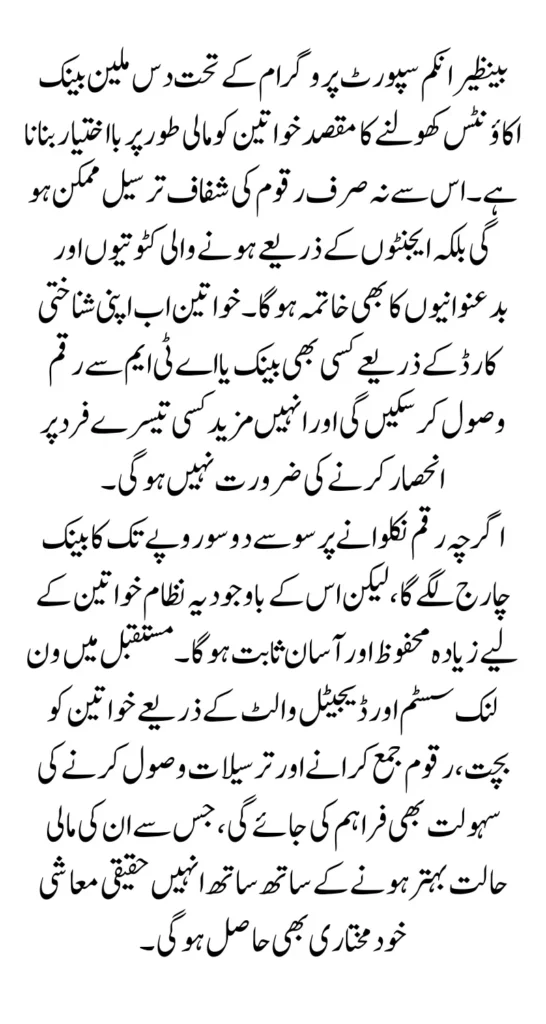BISP Bank Accounts Ready for Digital Transactions
BISP Bank Accounts Ready for Digital Transactions has entered a new phase of digital transformation by opening one crore (10 million) bank accounts for its beneficiaries. This initiative aims to give women across Pakistan direct access to modern banking services while removing middlemen from the process.

For years, beneficiaries faced challenges such as agent deductions, limited withdrawal options, and long queues. With the new accounts, they can now use banks and ATMs like regular account holders. However, a key point to note is that withdrawals will come with a standard bank fee of Rs 100 to Rs 200. This marks a significant shift in how social support is distributed, balancing greater financial inclusion with standard service charges.
You Can Also Read: E-Taxi Models List Announced Chose Your Favorite Car
Why These Accounts Were Opened
The idea of linking BISP stipends to bank accounts was driven by the government’s desire to promote transparency, reduce corruption, and modernize cash transfer methods. In the past, many beneficiaries had to rely on local agents who often deducted unfair amounts from their stipends. The introduction of these bank accounts will reduce such exploitation and give women full control over their financial support.
At the same time, the move helps Pakistan’s broader push toward digital financial inclusion. The Prime Minister had set an ambitious target of opening 10 million accounts within four months, and this goal has now been achieved. Although these accounts remain inactive for now, they will automatically become functional as soon as the first withdrawal is made. This ensures that the system remains efficient and secure until beneficiaries are ready to use it.
- Government initiative to modernize BISP payments.
- Reduction of fraud and exploitation from agents.
- Achievement of PM’s target: 10 million accounts in four months.
- Activation of accounts at the first withdrawal stage.
You Can Also Read: CM Punjab Green e-taxi Program Eligibility
How Beneficiaries Will Withdraw Money
One of the biggest advantages of the new system is that BISP customers will no longer need to depend on agents or designated campsites. Instead, they can directly approach any participating bank or use ATMs once their accounts are active. This new method makes access to funds more convenient and reliable.
To ensure smooth withdrawals, the process has been designed to be straightforward. Beneficiaries only need their valid CNIC to access the money. The removal of agents not only improves security but also restores dignity for women who previously had to go through lengthy, uncomfortable processes.
Withdrawal Steps for BISP Beneficiaries
- Visit any branch of the bank linked with BISP.
- Show your original CNIC at the counter.
- Withdraw your stipend directly from the teller or ATM.
- The first withdrawal activates your account permanently.
- Collect the printed receipt for your records.
This process is designed to make beneficiaries feel like valued customers rather than aid recipients, helping integrate them into the formal banking sector.
You Can Also Read: BISP 13500 Payment Linked to Daughters
Bank Charges for Withdrawals
While the new accounts bring empowerment and ease, they also introduce formal banking rules. Beneficiaries will be required to pay a withdrawal fee of Rs 100 to Rs 200 each time they take out money. These are standard charges that banks apply to maintain and operate accounts at such a large scale.
The Deputy Governor of the State Bank explained that this is necessary for ensuring banks can continue providing services, including ATMs, branches, and transaction monitoring. Importantly, this fee will be deducted by the bank itself and not by any agents, which eliminates the risk of unauthorized cuts.
- Withdrawal fee: Rs 100–200 per transaction.
- Deduction made by: The bank, not agents.
- Purpose of charges: Operational costs and service continuity.
You Can Also Read: Etaxi Punjab Online Registration Portal Open
Progress of Banks and Digital Integration
At present, six major banks are actively handling BISP accounts. These banks have started preparing for large-scale digital payments and are in the process of linking their systems to OneLink, a platform that connects banks and ATMs nationwide. The government expects this phase to be completed within the next six months, after which all beneficiaries will be able to withdraw money from any ATM or bank branch across Pakistan.
This digital integration will also allow beneficiaries to receive remittances, deposit savings, and potentially use digital wallets. Over time, these features will help women manage their finances better and engage in small-scale savings, which can improve household stability.
BISP Accounts at a Glance
| Feature | Current Status | Timeline/Details |
|---|---|---|
| Total Accounts | 1 crore (10 million) | Already created |
| Activation | On first withdrawal | Beneficiary CNIC required |
| Withdrawal Fee | Rs 100–200 | Deducted per transaction |
| Banks Onboard | 6 banks | More banks joining soon |
| OneLink Integration | In progress | To be completed in 6 months |
Benefits of the New System
The new digital approach provides many long-term benefits, particularly for women in rural and underprivileged areas. It reduces dependency on agents and improves access to formal financial services. By owning active bank accounts, women beneficiaries are not just stipend receivers; they are also participants in the financial system.
Key benefits include:
- Direct control over funds without interference.
- Access to remittances from family members in Pakistan or abroad.
- Secure records through official bank receipts.
- Chance to save money or use digital wallets in future.
- Financial dignity by being treated as proper bank customers.
Challenges for Beneficiaries
Despite the progress, certain challenges remain in making digital banking smooth and accessible. Many women, especially in remote areas, are not familiar with ATMs, mobile banking, or even formal banking systems. Limited access to branches in rural towns may also create difficulties. Additionally, the deduction of Rs 100–200 per withdrawal, although small in urban areas, could be significant for women relying solely on BISP stipends.
To address these issues, BISP and partner banks are considering awareness campaigns and training sessions for women. These will help beneficiaries learn how to use ATMs, identify fraud risks, and manage their accounts securely. With consistent support, these challenges can be reduced over time.
You Can Also Read: Taxi Scheme Application in Pakistan 2025
Conclusion
The launch of one crore BISP bank accounts is more than just an administrative milestone—it is a step toward digital empowerment for millions of Pakistani women. With agent-free withdrawals, access to banks and ATMs, and the future possibility of digital wallets, this initiative is reshaping how financial support reaches the poor. While withdrawal charges of Rs 100–200 may raise concerns, the benefits of transparency, security, and independence are far greater.
As more banks join and digital literacy improves, BISP beneficiaries will find themselves not only receiving aid but also building stronger financial identities. This change marks the beginning of a more inclusive and accountable welfare system in Pakistan.
You Can Also Read: Punjab E-Taxi Registration Deadline Only 16 Days


